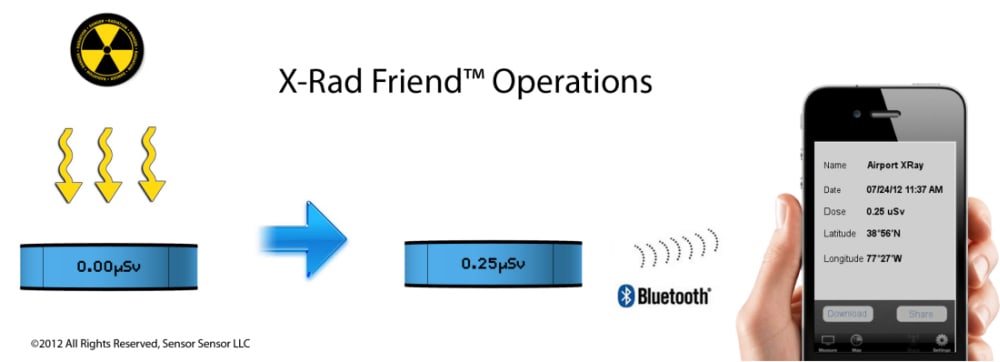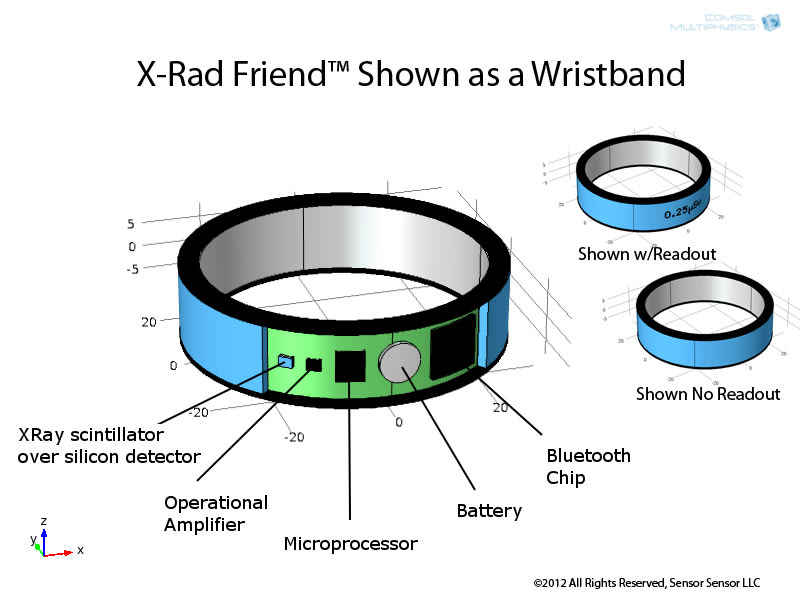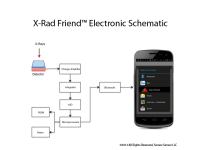
The Challenge
X-ray radiation exposure is a major concern for millions of travelers, baggage handlers, and workers in the medical industry and industrial and homeland security sectors. In 2011 the European Union has banned backscatter machines in airports due to uncertain X-ray radiation exposure, but in the United States and many other countries they are still in use. Other sources of X-ray radiation can be from building security scanners and the natural environment. Over exposure is shown to cause thyroid dysfunction and cancerous cell growth among other illnesses. A University of Berkeley study cites that “over 50% of the death rate from cancer, and over 60% of today’s death rate from ischemic heart disease are induced by X-rays in combination with other factors.” Existing technology does not allow for user-friendly, real-time, cost-effective X-ray radiation exposure monitoring.
The Solution – X-Rad Friend™
The worlds first personal X-ray radiation dosimeter that works with your smart phone to give you real-time, location-specific readings and keeps track of your accumulated dosage. X-Rad Friend™ in an easy-to-use consumer oriented wristband or clip.
The figures show possible bracelet designs and schematics of how X-Rad Friend™ works.
New Technology Design
The X-Rad Friend™ dosimeter, based on state-of-the-art NASA photodiode and scintillator technology, gives a precise measurement of radiation dose and has the ability to accurately track exposure over time. The dosimeter gives an instant readout using a smart phone application. A memory chip stores readings until they are synchronized with the users smart phone. Each user will have a pass-code protected unique user ID.
When a user wishes to view a dose reading they need to bring the X-Rad Friend™ near their smart phone and open the X-Rad Friend™ App. The data will download through Bluetooth technology. The GPS feature of smart phones will allow for a location record for each reading.
The smart phone application will keep track of the dosage by:
? Incident time, dose and location
? Dosage history by day/month/year
X-Rad Friend™ will be sensitive to:
? Minimum Dose: 0.03 µSv
? Lower Limit of Detection: 0.01 µSv
? Dose Range: 0.03 µSv - 5 Sv
? Photon Energy: 5 keV - 6 MeV
Unique features include:
? Design embedded in silicone
? Miniaturized electronics
? NASA developed X-ray detector technology
? Bluetooth/Smart Phone App technology
? Reliable archiving, reports and analysis via smart phone application
Marketability
Millions of people will use the X-Rad Friend™ as a vital step towards reducing over exposure to X-ray radiation and thus help reduce the incidence of cancers and other related illnesses.
The X-Rad Friend™ will be useful to the following groups:
? X-ray technicians, estimated 250,000+ positions in the USA.
? Security employees operating X-ray scanners
? Millions of travelers
? Those with wellness issues
Estimated costs
? R&D $500K?
? Marketing & PR $250K?
? Initial product launch cost $69 with free smart phone application
-
Awards
-
 2012 Top 100 Entries
2012 Top 100 Entries
Like this entry?
-
About the Entrant
- Name:Karin Edgett
- Type of entry:teamTeam members:Shahid Aslam
Karin Edgett
Nicolas Gorius - Software used for this entry:COMSOL, Power Point, Photoshop
- Patent status:pending
















